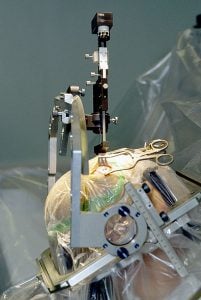Two patients freed from severe to disabling effects of dystonia through deep brain stimulation therapy continued to have symptom relief for months after their devices accidentally were fully or partly turned off, according to a report published online in the journal Movement Disorders.
“Current thought is that symptoms will worsen within hours or days of device shut-off, but these two young men continued to have clinical benefit despite interruption of DBS therapy for several months. To our knowledge, these two cases represent the longest duration of retained benefit in primary generalized dystonia. Moreover, when these patients’ symptoms did return, severity was far milder than it was before DBS,” said senior author Michele Tagliati, MD, director of the Movement Disorders Program at Cedars-Sinai’s Department of Neurology.
Dystonia causes muscles to contract, with the affected body part twisting involuntarily and symptoms ranging from mild to crippling. If drugs, which often have undesirable side effects, especially at higher doses, fail to give relief, neurosurgeons and neurologists may work together to supplement medications with deep brain stimulation, aimed at modulating abnormal nerve signals. Electrical leads are implanted in the brain, one on each side, and an electrical pulse generator is placed near the collarbone. The device is then programmed with a remote, hand-held controller. Tagliati is an expert in device programming, which fine-tunes stimulation for individual patients.

Few studies have looked at the consequences of interrupted DBS therapy, although one found “fairly rapid worsening of dystonia in 14 patients after interruption of stimulation for 48 hours, with symptom severity at times becoming worse than the pre-operative baseline.” In another study of 10 patients with generalized dystonia, however, symptoms did not return in four patients when stimulation was discontinued for 48 hours.
Findings from the 10-patient study correlate well with these two cases, Tagliati said.
“It appears that several factors; age, duration of disease, length of time the patient has received DBS treatment and stimulation parameters, determine which patients may retain symptom relief after prolonged DBS interruption. Our two patients were young, 20 years old. They both began DBS therapy a relatively short time after disease onset; one at four years and the other at seven years. One had received continuous stimulation for five years and the other for 18 months before stimulation was interrupted,” Tagliati said.
“We can’t say for certain why these factors make the difference,” he added, “But we theorize that a younger brain with shorter exposure to the negative effects of dystonia may be more responsive to therapy and have greater ‘plasticity’ to adapt back to normal. Both of our patients received DBS therapy at a lower energy than most patients experience, suggesting the possibility that low-frequency stimulation over an extended time may help retrain the brain’s low-frequency electrical activity.”
Both instances of device shut-off were accidental and were discovered during doctor visits after mild symptoms returned. The patient who had undergone five years of DBS therapy had only one stimulator turned off for about three months; the one stimulating the left side of his brain remained active. In the other patient, the left device had been off for about seven months and the right one for two months, Tagliati said.
Tagliati was senior author of a 2011 Journal of Neurology article on a study showing that for patients suffering from dystonia, deep brain therapy tends to get better, quicker results when started earlier rather than later.
“We knew from earlier work that younger patients with shorter disease duration had better clinical outcomes in the short term. In our 2011 article, we reported that they fare best in the long term, as well. That study uniquely showed that age and disease duration play complementary roles in predicting long-term clinical outcomes. The good news for older patients is that while they may not see the rapid gains of younger patients, their symptoms may gradually improve over several years,” Tagliati said.
Notes about this neurology research
Tagliati has received speaker honoraria from Medtronic, Inc., and consultation fees from St. Jude Medical, Inc., Abbott Laboratories and Impax Laboratories, Inc., unrelated to this study.
Contact: Sandy Van – Cedars-Sinai Medical Center
Source: Cedars-Sinai Medical Center press release
Image Source: Image credited to Thomasbg at Wikimedia Commons and is licensed as Creative Commons Attribution-Share Alike 3.0 Unported.
Original Research: Abstract for “Sustained Relief of Generalized Dystonia Despite Prolonged Interruption of Deep Brain Stimulation by Tyler Cheung MD, Cen Zhang MD, Joseph Rudolph MD, Ron L. Alterman MD and Michele Tagliati MD, FAAN in Movement Disorders. Published online February 11 2013 DOI: 10.1002/mds.25353
Abstract for “Factors predicting protracted improvement after pallidal DBS for primary dystonia: the role of age and disease duration” by Ioannis U. Isaias, Jens Volkmann, Andreas Kupsch, Jean-Marc Burgunder, Jill L. Ostrem, Ron L. Alterman, Hubertus Maximilian Mehdorn, Thomas Schönecker, Joachim K. Krauss, Philip Starr, Rene Reese, Andrea A. Kühn, W. M. Michael Schüpbach and Michele Tagliati in Journal of Neurology. Published online August 2011 doi:10.1007/s00415-011-5961-9







